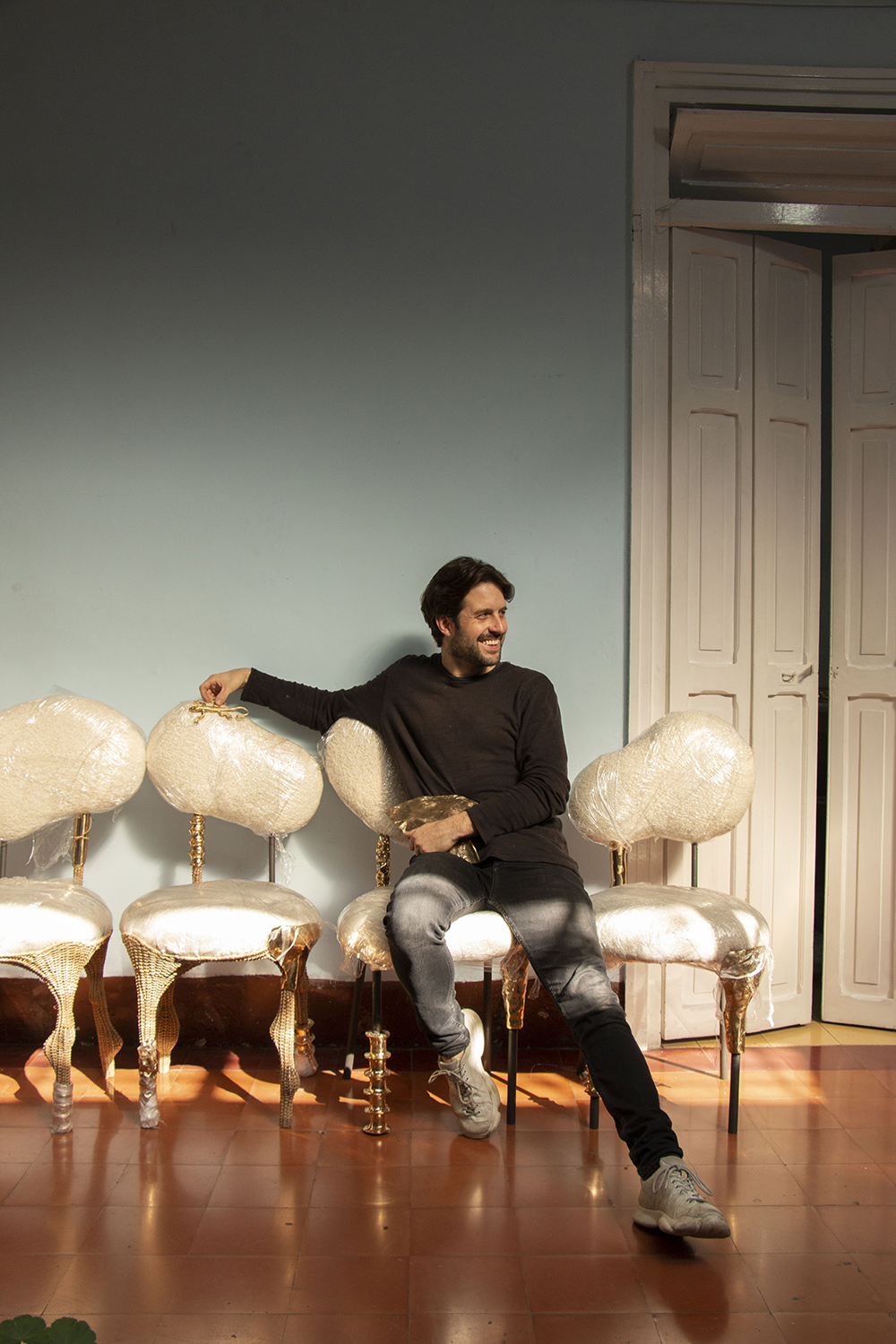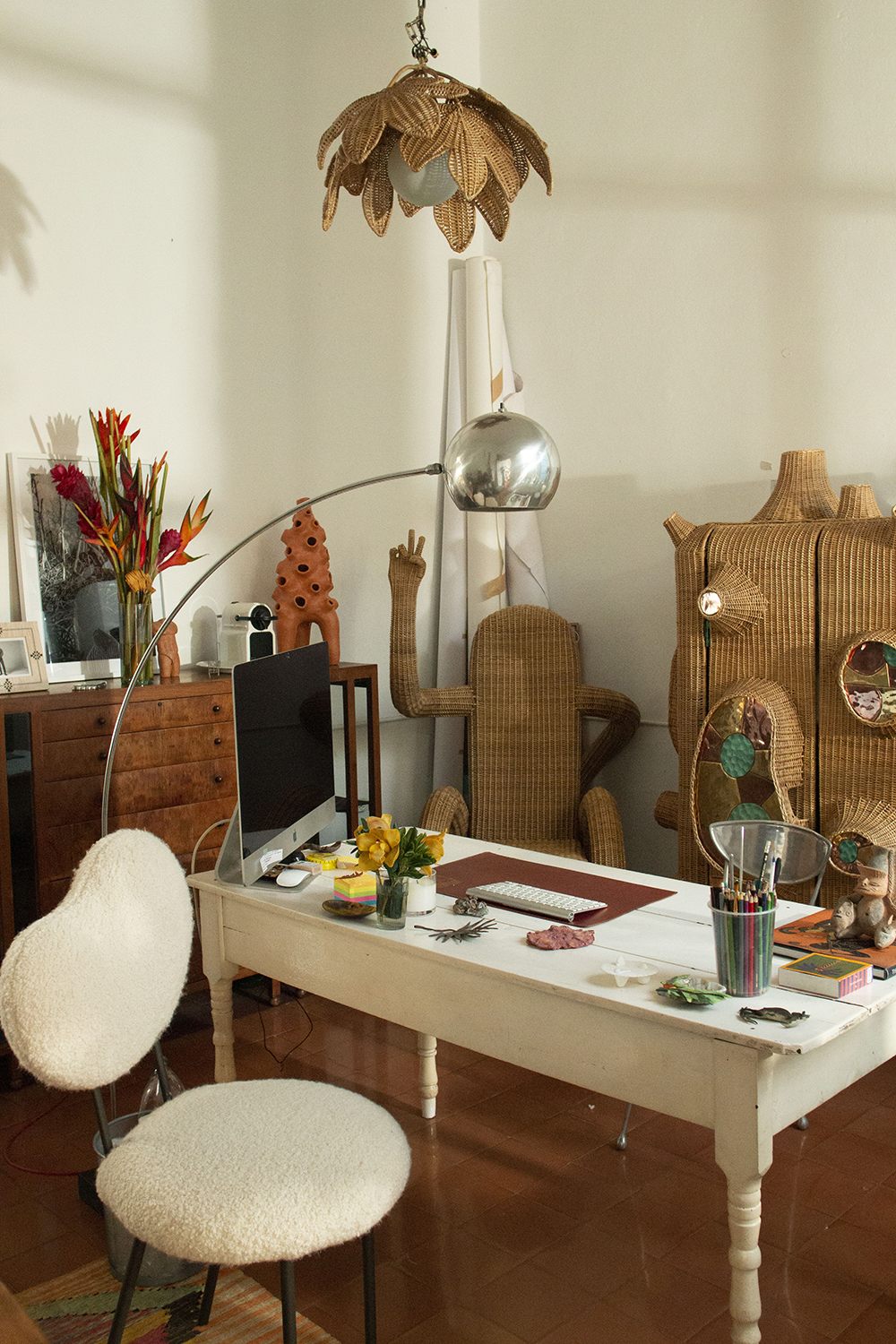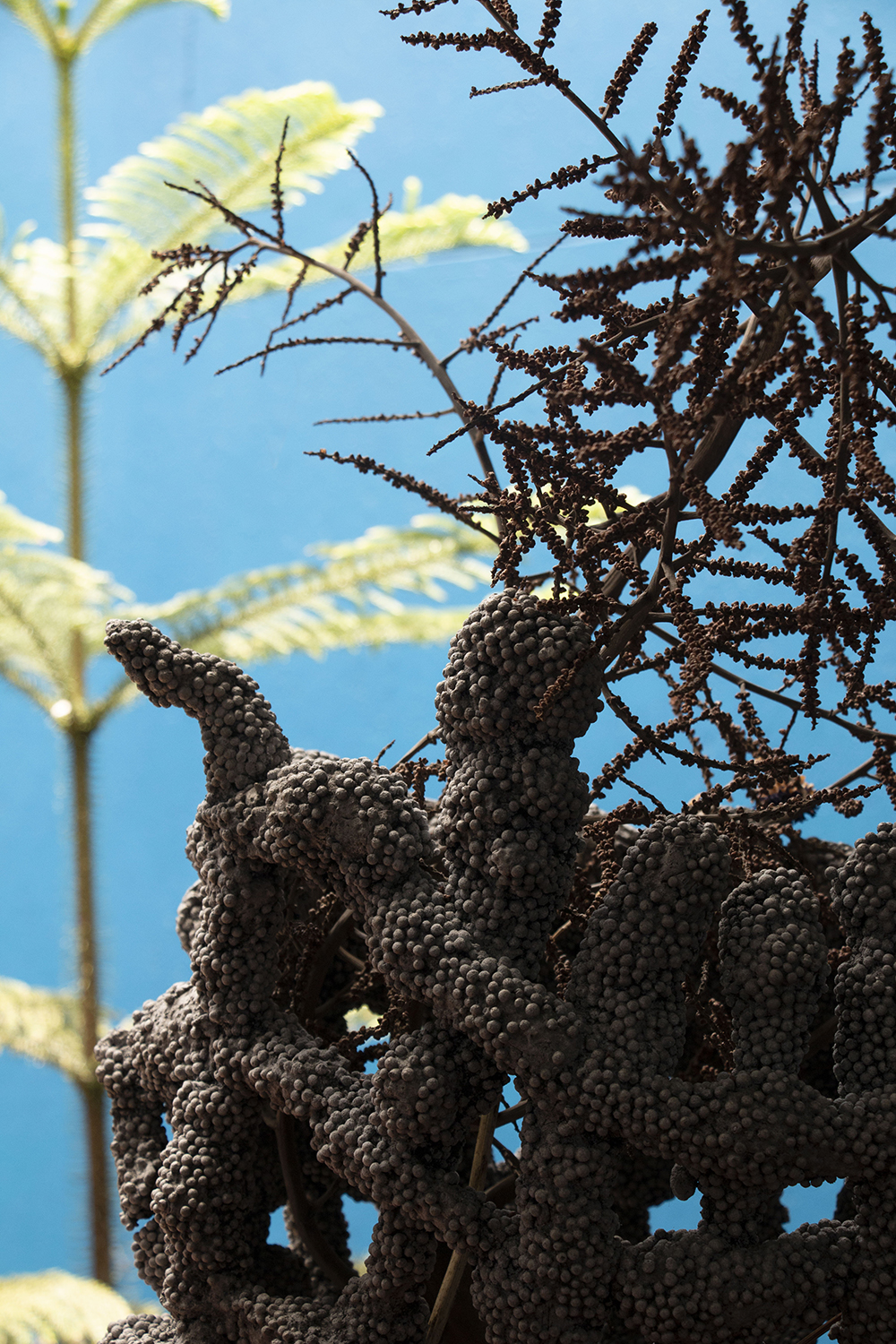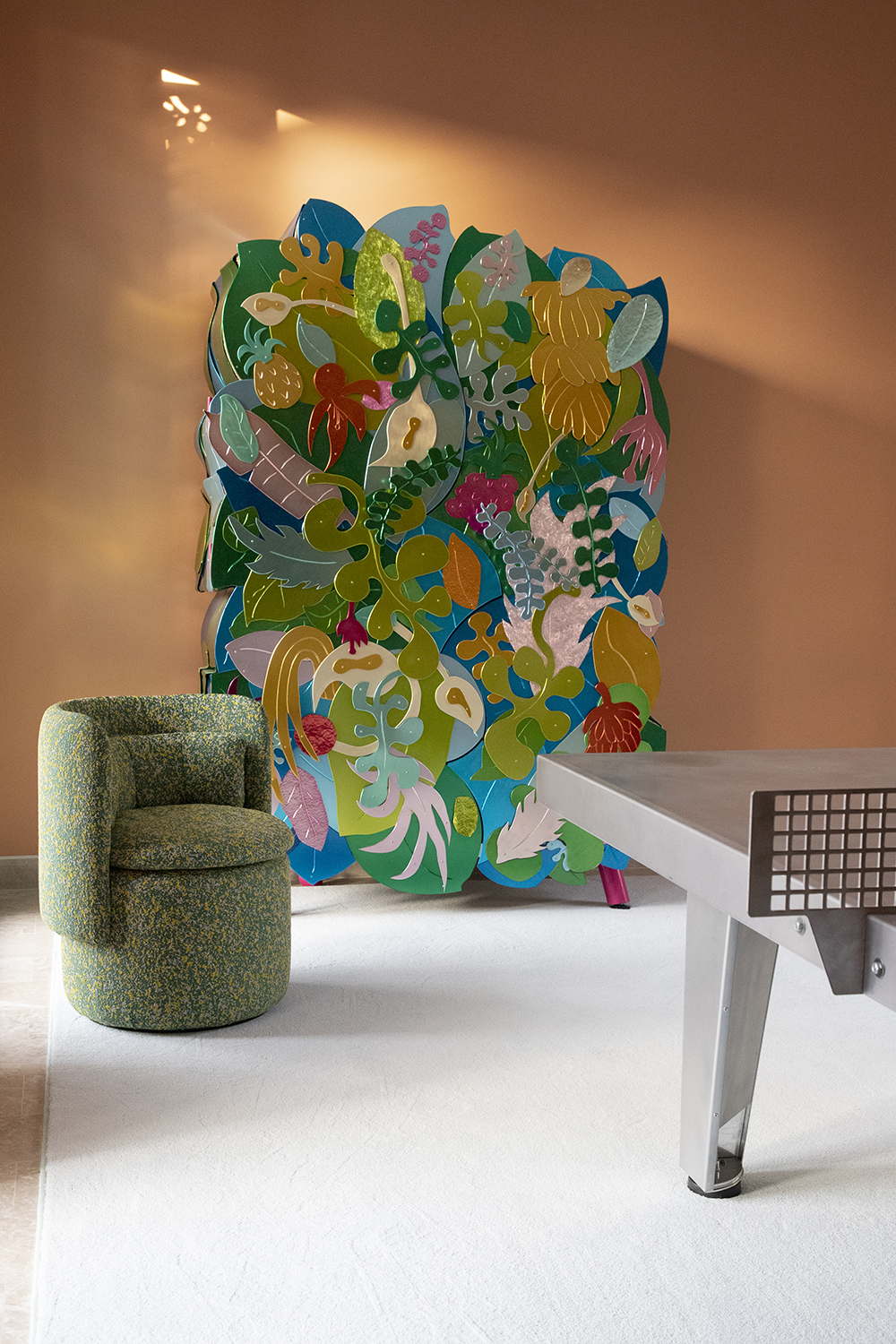The multidisciplinary work focused on understanding and experimenting with materials, used as means to explore human relationships, has highlighted the work of Chris Wolston. As a designer, he has been interested in non-Western artistic traditions through his studies at the Kokrobitey Institute in Accra, Ghana, before receiving his Bachelor of Fine Arts from the Rhode Island School of Design. In 2013, he obtained a Fulbright scholarship to study pre-Columbian ceramics, and thus began her creative process in Colombia.
His carefully conceptualized work ranges from furniture and lighting to installations and sculptures, where he combines traditional techniques and materials with an ironic naturalism, reaching a contemporary language. With a wide reach on the international art and design scene, his work is in the permanent collections of the American Glass Museum, the Antioquia Museum in Medellín, Colombia, the Qatar National Museum, the Odunpazarı Modern Müze (OMM) in Turkey and the National Gallery of Victoria in Melbourne. It was recently featured in T Magazine, Architectural Digest, Elle Decor Italia, Domino, and Surface Magazine. He has created work for brands such as Philip Lim, FENDI, Dior and recently for Dolce & Gabbana at Milan Design Week 2023.

We exclusively interviewed Chris and met his studio in Medellín, and he tells us about his early career, his interests and the artisanal processes in his work.
EXCLAMA: You are an American designer who studied at the Rhode Island School of Design. How did you come to Colombia, and when did you decide to stay to open your studio in Medellín?
CHRIS WOLSTON: I came to Colombia in 2012 with one of my classmates from the Rhode Island School of Design. We were interested in applying for a Fulbright scholarship that focused on exploring craft and materials, using materials research and experimentation as a route to creating sculpture. I spoke with my colleague Andrés Monzón, and he suggested that I go to Campos de Gutiérrez to do my research. So, I went to Medellín for the first time in 2012 for three months and fell in love with the city, then I decided that I was going to come back for my Fulbright scholarship the following year and it happened.
From Medellín, I was fascinated by the fact that terracotta is a material that exists in different contexts: it is historically present in pre-Columbian ceramics and in contemporary ones. My fellowship was from 2013 to 2014 and after that I established a small studio in Medellín and moved between New York and Medellín until 2018. That year I had my first solo show with The Future Perfect and by spending more time in my Medellín studio I wanted to move my studio from Brooklyn to combine both studios. My studio was in Santa Elena, but when we did the Los Huesos collection, we moved to a space next to the foundry in Niquitao; the studio was located there for approximately two years, and finally we moved to Prado Centro.

E: When you began to develop your work as a designer, you wanted to work in collaboration with local artisans. Why has this collaborative work interested you?
C.W: One of the things that interests me about furniture is that it’s relational. As a medium, it is perfect for creating this connection between humans and materiality. I always say that people are intimate with their furniture; when you’re sitting on a sofa or in a chair there’s a very natural interaction that takes place, and so I thought it was an interesting way to explore the material and work with artisans; with that we can say that this is where my first furniture collection came from. For the process of making furniture, I was thinking of it as a relational sculpture.
When I have a new idea to use wicker, like the pairs of Mafafa Club Chairs that I did for Design Miami in 2022, there’s a very exciting process that takes place working with the weaver artisans to figure out how we use this material and achieve the shape I have in mind. At first, they say it’s impossible, that we can’t apply the wicker like the way I wanted, and then it’s a kind of trial and error, and we always reach a point where the result is possible.
E: You are a multidisciplinary designer, and, in each project, object and collaboration, we can see a quite captivating creative explosion. What are your main sources of inspiration?
C.W: As an artist it’s important to always present new ideas and collections of work, so whenever I’m going to have an exhibition, I always want to push myself into exploring new territory, whether it’s in forms of production or material. So, when it comes to working with common materials, for example wicker or cast aluminum, I’m interested in taking the materials to recontextualize their use, either from the technique behind them or the form; and much of the visual inspiration has come from my garden and landscape.
Although not all the images are of flora and plants, there are symmetries and visual elements that I personally find very inspiring in the landscape, so it’s often a big influence on me. At home, I have a garden that I have been working on for years and when I am not in the studio, I am in the garden.



E: Of your projects and objects developed so far, is there one that you consider your «favorite»?
C.W: It’s an interesting question because I’ve created a lot of work with different aesthetics, but I think one of my favorites is the Oro chair, which is an upholstered dining chair that combines wicker with bronze. It’s interesting to me because usually when we make chairs, it’s sets of eight or twelve, and dining room chairs are standard. With Oro chairs, each chair is unique. The bronze pieces are sculpted with wax in the studio and then cast, the rattan is applied in the studio, and although they are part of a series, at the same time they are all individual.
Oro Chair, Chris Wolston Studio. Video: David Sierra.
E: Your work confirms that you have carried out very rigorous research on the materials you use such as terracotta and ceramic processes, sand-cast aluminum, wicker weaving, etc. Could we say that it is the material that connects people with objects and things?
C.W: Yeah, people know what material they’re interacting with; So, I think that through the application of materials in new formats and through the reinvention of artisan techniques, visual questions are asked for these people to answer. With craft materials, we are never inventing something new. For example, weaving is one of the oldest techniques we know of, and so is ceramics, but as an artist and designer, it’s all about creating a process or practice that applies the material in new ways. In terms of regionalism, terracotta serves many functions and is found in different areas. In addition, it is a completely natural material extracted from the earth. Most of the clays used in the United States are manufactured, which means that the natural elements of the clay are mixed in a measured way. Instead, the clay we use in Medellín is extracted directly from the mountain.
If we go back in history, we can probably find applications of similar materials that have been executed differently before. But as artists, we look at our environment, respond to it, and question it in ways that are new. So yes, I think that the material is what connects people with objects and things, and it is also an important tool to ask questions and create new experiences.
E: Continuing with the materials, is there any interest in your projects to reflect on caring for the planet and the environment today?
C.W: Terracotta is a universal material, and it’s also from the earth; the same goes for wicker or sand-cast aluminum. Sometimes I’m working in the studio, and I think to myself, what if all these consumer products had more innovative uses for them, that revamped these materials that have been around for centuries? I think glass is another rather interesting material. So maybe it’s more of a wish. I think that in a way there could be more innovative solutions for packaging that are not necessarily plastic. I think there is territory there for significant exploration.
The materials are pure, but in the process, you must verify how you are doing your work with the environment and how you are working with these materials such as boxes and plastics. One of the ways that I can talk about how my work or how my practice can improve the environment is that with my work I like to create forums that require physical interaction and lead to people asking questions or having ideas about the material. Thinking about the material experience in a new way can lead people to think about holistic materials.


E: We see in your designs furniture that has humanoid characteristics such as buttock chairs, chairs with hands and feet, etc. How did the idea of mixing furniture with human forms come about?
C.W: As we’ve talked about, the pieces exist as relational sculptures and part of what’s considered is the human form. Another element that integrates the human form is the process, ceramics and wicker are directly molded and woven by hand. The human hand is something that I use a lot and think about a lot, and I believe that this ability enters the visual nature of the work and into the reflection on the relationship between the physicality of the material and human physicality. The works are explorations of this.

E: Have you had any idea that for reasons of materials or other aspects you have not been able to develop?
C.W: I studied glass at RISD and haven’t worked with glass in several years; so, with the current project for Dolce & Gabbana in MDW, it’s been very interesting to go back to glass. RISD’s glass program is a rigorous exploration of conceptual materials, and I looked over my shoulder at Venetian glass, and for me Venetian glass is so visual and decorative that I have moved away from that bias with the material. It’s lovely to go back to glass and work with it on this piece. For the Dolce & Gabbana project they told us: «Here is our list of ideas for the project: bring designers from other places to explore Italian craftsmanship.» And they gave us a list of all their makers, craftsmen, and people we could potentially work with. I was interested in going to Murano and working with traditional chandelier makers. So, it’s quite like the process in Colombia because the inspiration to work with glass in Italy also comes from the landscape of Antioquia.
It is fascinating! A couple of years ago, during New Years, we were in Barbosa, Colombia and they had invited me to do this project and I was thinking about it. There were pitahaya’s fruit growing there and it had this incredibly rocky landscape and the rocks, and the trees were covered in cactus vines, and somehow, I don’t know if by chance, it reminded me a lot of southern Italy and Sicily. The Dolce & Gabbana aesthetic is a very southern Italian thing, in a lot of their work there are always references to southern Italy, so I thought, «Wow, this is wild! I’m in this landscape that is so particular to Antioquia.

E: Your work has been quite successful around the world, to the point that you have already collaborated with fashion and design houses such as Fendi or Dior. How do you feel about the work processes with these brands?
C.W: It’s very important because fashion brands are globally recognized and there’s a widespread understanding of them. When working with the brand, there are always complexities and elements that are very special that arise in the process. As an artist it is a truly enriching experience because in most there is a focus and deep exploration of materials and craft that is inspiring.
One of the things about luxury brands is that they have the people who make the products, whether they are leather workers or millers, manufacturers or craftsmen who are the ultimate specialist in that technique. And so, in my own practice I also look for specialists. Stepping into that world, I can see how the material is obsessively worked to its full potential. Luxury is the ultimate exploration of craftsmanship in a sense, and brands have a very keen interest in finding, through regional exploration, people who are highly skilled and technically exquisitely capable. One of the things about these fashion houses is that when it comes to materiality, their ultimate level of exploration is exquisitely pure.
E: How is your career now and what are your future projects?
C.W: Well, I have an exhibition opening in New York in May 2023 with The Future Perfect. This project is a collection of terracotta works. I have never presented a complete collection of terracotta furniture. As a designer I emerged working with terracotta and this will be a presentation of new ceramic works that focuses on the material itself. The inspiration for this collection comes from my garden and the landscape. For the exhibition, I have created press molds of flowers from the garden of la Placita de Flórez and other nearby places in Medellín.


